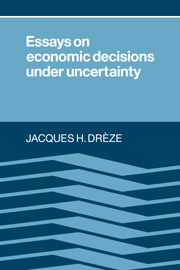Book contents
- Frontmatter
- Contents
- Acknowledgements
- Foreword
- I Decision-making under uncertainty: general theory
- II Markets and prices
- III Consumer decisions
- IV Producer decisions
- V Theory of the firm
- 14 Investment under private ownership: optimality, equilibrium and stability
- 15 Decision criteria for business firms
- 16 (Uncertainty and) the firm in general equilibrium theory
- IV Human capital and labour contracts
- VII Public decisions
- Index
14 - Investment under private ownership: optimality, equilibrium and stability
Published online by Cambridge University Press: 01 October 2009
- Frontmatter
- Contents
- Acknowledgements
- Foreword
- I Decision-making under uncertainty: general theory
- II Markets and prices
- III Consumer decisions
- IV Producer decisions
- V Theory of the firm
- 14 Investment under private ownership: optimality, equilibrium and stability
- 15 Decision criteria for business firms
- 16 (Uncertainty and) the firm in general equilibrium theory
- IV Human capital and labour contracts
- VII Public decisions
- Index
Summary
Introduction
General equilibrium under uncertainty
The theory of equilibrium and efficiency of resource allocation, initially developed for a world of certainty, has been reinterpreted for a world of uncertainty, thanks to a suggestion made by Arrow (1953) and pursued further by Debreu (1959).
An economy is defined by (i) a set of commodities, with the total resources (quantities of these commodities) initially available; (ii) a set of consumers, with their consumption sets and preferences; (iii) a set of producers, with their production sets. The resources, consumption sets and production sets define the physical environment. In a world of certainty, the environment is given. In a world of uncertainty, the environment depends upon uncertain events. Let these be determined by ‘the choice that nature makes among a finite number of alternatives’ (Debreu, 1959, p. 98).
The reinterpretation consists in defining a commodity not only by its physical properties (including the time and place at which it is available) but also by an event conditional upon which it is available. An allocation then specifies the consumption of every consumer and the production of every producer, conditional on every event. Uncertainty means that these consumptions and productions may vary with the event that obtains.
Consumer preferences are defined over commodity vectors, that is, over plans specifying fully the consumption associated with every event. These preferences are introduced as a primitive concept.
- Type
- Chapter
- Information
- Essays on Economic Decisions under Uncertainty , pp. 261 - 297Publisher: Cambridge University PressPrint publication year: 1987
- 2
- Cited by

